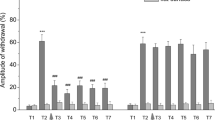Abstract
We report here a study of the effects of blockade of protein synthesis with anisomycin during reactivation of a contextual conditioned reflex in the common snail. The amplitudes of the defensive reactions of snails to standard tactile stimulation before training were identical in two conditions: 1) testing of responses of snails fixed by the shell to a plastic ball floating in water and 2) on the surface of the terrarium glass. After applying electric shocks to the snails' skin for 5 days, a significant difference in responses reflecting the formation of a contextual conditioned reflex was seen in only one of the contexts. Placing trained snails in the same context (reminding) two days after training with simultaneous injection of anisomycin led to significant weakening of training, while control injections of physiological saline produced no such changes. These data suggest that the mechanisms of memory consolidation after training and reminding are not identical.
Similar content being viewed by others
REFERENCES
P. M. Balaban and I. S. Zakharov, Learning and Development — A Basis for Two Phenomena [in Russian], Nauka, Moscow (1991).
A. V. Shevelkin, “Facilitation of defensive reactions during food consumption in common snails: involvement of glucose and gastrin/cholecystokinin-like peptide,” Zh. Vyssh. Nerv. Deyat., 42, No.6, 1235–1249 (1992).
K. V. Anokhin, A. A. Tiunova, and S. P. Rose, “Reminder effects-reconsolidation or retrieval deficit? Pharmacological dissection with protein synthesis inhibitors following reminder for a passive-avoidance task in young chicks,” Eur. J. Neurosci., 15, No.11, 1759–1765 (2002).
Y. I. Arshavsky, “Cellular and network properties in the functioning of the nervous system: from central pattern generators to cognition,” Brain Res. Rev., 41, No.2, 229–267 (2003).
P. M. Balaban, “Declarative and procedural memory in animals with simple nervous systems,” in: Psychology at the Turn of the Millennium, C. Hofsten (ed.), Academic Press, Stockholm (2002), Vol. 1, pp. 1–28.
P. M. Balaban, “Cellular mechanisms of behavioral plasticity in terrestrial snail,” Neurosci. Biobehav. Rev., 26, No.5, 597–630 (2002).
P. M. Balaban and N. I. Bravarenko, “Long-term sensitization and environmental conditioning in terrestrial cells,” Exptl. Brain Res., 96, No.2, 487–493 (1993).
R. Bourtchouladze, T. Abel, and N. Berman, “Different training procedures recruit either one or two critical periods for contextual memory consolidation, each of which requires protein synthesis and PKA,” Learn. Mem., 5, No.2, 365–374 (1998).
T. J. Carew and M. A. Sutton, “Molecular stepping stones in memory consolidation,” Nat. Neurosci., 4, No.8, 769–771 (2001).
T. Crow, J. J. Xue-Bian, and V. Siddiq, “Protein synthesis-dependent and mRNA synthesis-independent intermediate phase of memory in Hermissenda,” J. Neurophysiol., 82, No.3, 495–500 (1999).
H. P. Davis and L. R. Squire, “Protein synthesis and memory: a review,” Psychological. Bull., 96, No.4, 518–559 (1984).
T. Hamakawa, M. A. Woodin, and M. C. Bjorgum, “Excitatory synaptogenesis between identified Lymnaea neurons requires extrinsic trophic factors and is mediated by receptor tyrosine kinases,” J. Neurosci., 19, No.21, 9306–9312 (1999).
J. Maulshagen, G. R. Parker, and T. J. Carew, “Dynamics of induction and expression of long-term synaptic facilitation in Aplysia,” J. Neurosci., 16, No.18, 7099–7108 (1996).
J. L. McGaugh, “Memory-a century of consolidation,” Science, 287, No.5451, 248–251 (2000).
J. R. Misanin, R. R. Miller, and D. J. Lewis, “Retrograde amnesia produced by electroconvulsive shock after reactivation of a consolidated memory trace,” Science, 160, No.827, 554–555 (1968).
K. Nader, G. E. Schafe, and J. E. LeDoux, “Fear memories require protein synthesis in the amygdala for reconsolidation after retrieval,” Nature, 406, No.6797, 722–726 (2000).
J. Quevedo, M. R. M. Vianno, and R. Roesler, “Two time windows of anisomycine-induced amnesia for inhibitory avoidance training in rats: protection from amnesia by pretraining but not pre-exposure to the task apparatus,” Learn. Mem., 6, No.4, 600–607 (1999).
S. J. Sara, “Retrieval and reconsolidation: toward a neurobiology of remembering,” Learn. Mem., 7, No.1, 73–84 (2000).
M. A. Sutton and T. J. Carew, “Parallel molecular pathways mediate expression of distinct forms of intermediate-term facilitation at tail sensory-motor synapses in Aplysia,” 26, No.1, 219–231 (2000).
M. A. Sutton, J. Ide, S. E. Masters, and T. J. Carew, “Interaction between amount and pattern of training in the induction of intermediate-and long-term memory for sensitization in Aplysia,” Learn. Mem., 9, No.1, 29–40 (2002).
S. M. Taubenfield, M. H. Milekic, B. Monti, and C. M. Alberini, “The consolidation of new but not reactivated memory requires hippocampal C/EBPbeta,” Nat. Neurosci., 8, No.8, 813–818 (2001).
A. A. Tiunova, K. V. Anokhin, and S. P. Rose, “Two critical periods of protein and glycoprotein synthesis in memory consolidation for visual categorization learning in chick,” Learn. Mem., 4, No.4, 401–410 (1998).
Author information
Authors and Affiliations
Additional information
__________
Translated from Zhurnal Vysshei Nervnoi Deyatel'nosti imeni I. P. Pavlova, Vol. 54, No. 6, pp. 795–800, November–December, 2004.
Rights and permissions
About this article
Cite this article
Gainutdinova, T.K., Tagirova, R.R., Ismailova, A.I. et al. Protein Synthesis-Dependent Reactivation of a Contextual Conditioned Reflex in the Common Snail. Neurosci Behav Physiol 36, 203–207 (2006). https://doi.org/10.1007/s11055-005-0179-x
Received:
Accepted:
Issue Date:
DOI: https://doi.org/10.1007/s11055-005-0179-x



